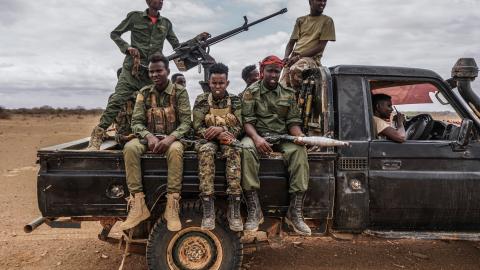Executive Summary
Analysts have long understood the war against al-Shabaab, al-Qaeda’s East African affiliate, as “unwinnable” and “[with] no end in sight.” Most have considered the group one of the largest and most sophisticated jihadist insurgencies on the planet while viewing Somalia, the state in which it was born and primarily operates, as a quintessential “failed state.” Yet in mid-2022, many analysts began to change their tune. Al-Shabaab began to suffer its most significant setbacks in a decade at the hands of a clan uprising in Somalia’s central states of Hirshabelle and Galmudug. The uprising quickly received military support from the Federal Government of Somalia (FGS), and some United States officials believe it constitutes Somalia’s Anbar Awakening. Meanwhile, Somali officials speak of this offensive, which they’ve now dubbed Operation Black Lion, as the long-awaited death blow against the group.
Unfortunately, the pendulum started to swing back after al-Shabaab began regrouping and counterattacking in early 2023. As of September 2023, the Somali government is struggling to complete the offensive that began last year in central Somalia. All the while, the government promises to achieve ever more ambitious goals for defeating the group in its southern Somalian strongholds by the end of 2024. The question, then, is whether Somalia is really turning a page in the war against al-Shabaab, with the group’s defeat or meaningful degradation in sight for the first time in years, or if the FGS’s battlefield progress in 2022 was merely a short-lived setback for the terrorist group.
In this report, I argue that the ongoing, if faltering, offensive against al-Shabaab reveals the dilemma of counterterrorism in the Horn of Africa: On the one hand, al-Shabaab is not invincible, and the group’s center of gravity—its ability to gain a modicum of acceptance or legitimacy from vulnerable Somali communities—has been exposed as fragile. On the other hand, Somalia’s perennial and myriad political disputes, as well as other issues like a lack of state capacity and rampant corruption, are preventing its federal and state governments from capitalizing on the opportunities available to them. Instead, Mogadishu, aware of its limited military capacity, is looking to the militaries of neighboring Kenya and Ethiopia to bear the brunt of its anticipated offensive into southern Somalia, even though these countries’ controversial interventions in Somalia over the years have catalyzed al-Shabaab’s formation and expansion. In any case, there appears to be little appetite from either country to engage in another offensive. Al-Shabaab, for its part, is counterattacking against government forces in central Somalia and looking to expand its operations in neighboring countries—in part to hinder those regional militaries’ potential participation in any forthcoming offensive.
Consequently, the situation looks less promising than it did at the end of 2022, and al-Shabaab is unlikely to face a meaningful defeat in the coming months. Instead, the best-case scenario would see this military offensive degrade al-Shabaab over the coming months to the point that the terrorist organization partially fractures and loses some of its popular support, possibly opening up room for the FGS to negotiate with factions of the group. A more likely scenario, however, would see the conflict remain a stalemate, with the government’s current offensive bringing only temporary or superficial gains that do not meaningfully degrade al-Shabaab’s capacity.
I have drawn this report from insights I gained during a four-week trip to Kenya and Somalia in June 2023. Within Somalia, I traveled around the federal capital, Mogadishu, as well as the capitals of the states of Jubbaland, Galmudug, and Puntland, in the south, center, and north of the country respectively. I also traveled to the frontline town of Bar Sanguuni, near al-Shabaab–controlled territory in Jubbaland, and separately to Las Anod, a disputed city that both Somaliland and local clans have claimed and that is at the heart of a new regional conflict. Given the sensitivity of discussing security matters in Somalia, I have anonymized the details of interview subjects in almost all references.

















